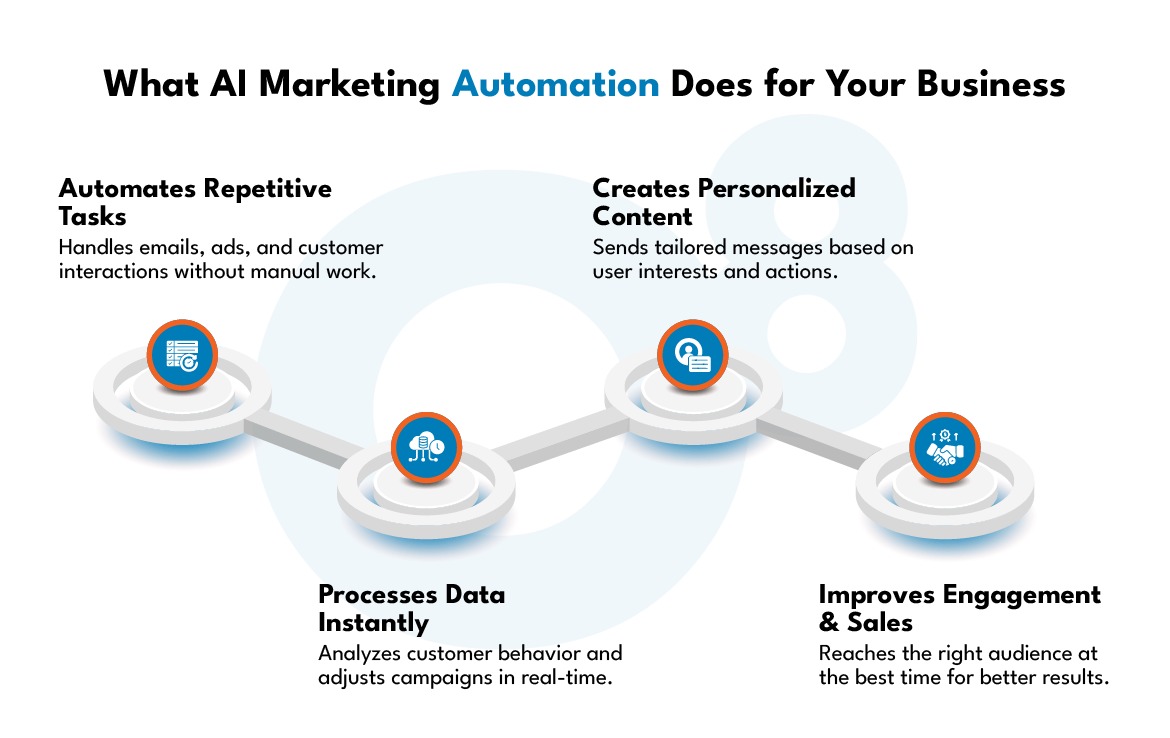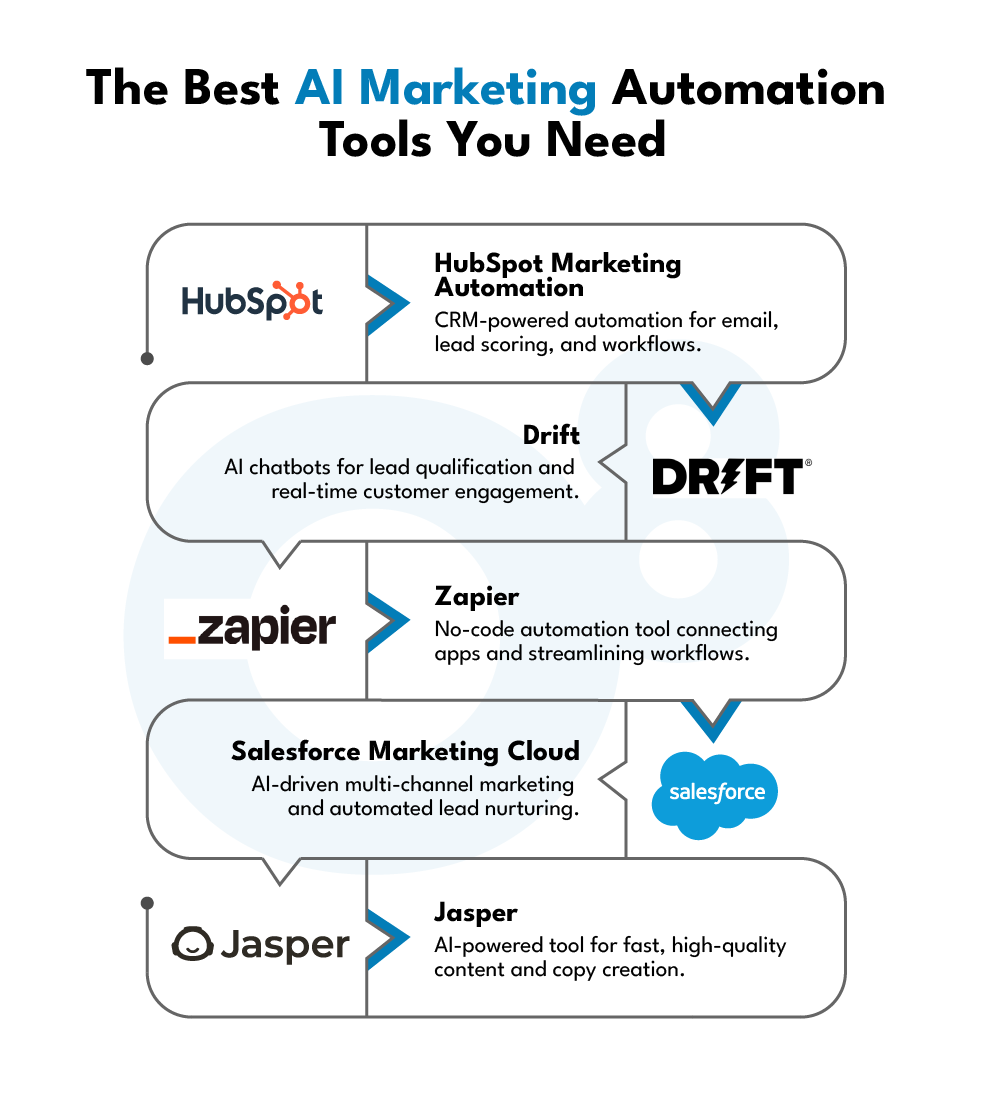AI Marketing Automation That Works Without Losing the Human Touch

- AI marketing automation boosts speed, personalization, and decision-making when guided by strategy and data.
- Automate admin tasks like email flows; keep client-facing moments human.
- AI should support, not replace, real conversations and nuanced decisions.
- Choose AI marketing automation tools that fit your team’s workflows, not just feature lists.
- If you want to start automating your marketing function, start small, test, improve, and then scale your automated workflows gradually.
- To measure the impact that AI marketing automation can bring to your business, split test automation workflow versus manual processes.
Automate tasks, not relationships.
That was the key theme that kicked off our new podcast series here at O8, where we discussed AI marketing automation and holistic marketing systems, what works, what breaks, and how to build smarter processes that support, not sabotage, your customer experience.
This first episode tackled a big question: How do we become more efficient without losing the human connection that drives trust and conversions?
As a AI-powered agency, we're big believers that marketing automation can do wonders, from scheduling content and scoring leads to streamlining email campaigns. But without intentional strategy and empathy, it can just as easily backfire, creating robotic, impersonal experiences that damage your brand.
“Use your workflow with a touch of AI. Treat it like onboarding an assistant, it filters, it routes, but you still own the human moments.”
Karen Peralta, Fractional COO, O8
Whether you're a growing business wearing many hats or a large team refining your processes, this episode is packed with practical insights for marketers, sales teams, and founders who want to automate the right things, and do it without sacrificing connection.
Here’s what we unpacked during the podcast:
- Which tasks are ideal for AI automation (and which aren’t)
- How to use any AI marketing tool without sounding like a bot
- How smarter systems can enhance, not replace, real human interaction
- How to measure impact and build workflows that grow with you
What Does AI Marketing Automation Mean?
At its core, AI marketing automation refers to the use of artificial intelligence and automation technology to streamline and enhance marketing tasks. If you use them correctly, AI marketing automation tools help you scale, streamline, and make smarter calls without sidelining your team.

Automation in marketing has been around for a while; since the early 2010s, we've been able to send pre-set emails when someone downloads a lead magnet. But today, AI-driven automation takes it much further. Now, you can analyze customer behavior on a large scale, segment audiences more intelligently, and personalize follow-up sequences in real time.
And it’s gaining traction, fast.
Recent stats show that:
- 52% of U.S. marketers using AI tools say it’s improved speed and workflow efficiency.
- 63% of marketing leaders use automation in email marketing specifically.
- 80% of users say marketing automation has helped them generate more leads, while 77% increase conversions.
The difference with AI-powered marketing automation is that you’re not just automating actions, you’re improving decision-making with machine learning, customer insights, and predictive models that evolve as your business does.
Done right, it helps teams:
- Respond faster across platforms
- Personalize at scale
- Free up time for strategic thinking
- Reduce repetitive tasks
As I shared early in this podcast episode, the goal isn’t to hand everything over to an AI algorithm. The goal is to automate what’s repeatable, so you as a marketer can focus on what actually moves the needle.
Smart Automation Strategies: What to Automate vs. What Needs a Human Touch
In our conversation, we kept circling back to a simple truth: not everything should be automated. The real challenge isn’t just finding the right AI tool, it’s knowing when to step in as a human.
We talked through the kinds of tasks that benefit from automation or generative AI tools, those repetitive, manual jobs that eat up time without needing much judgment. Things like:
- Email sequences (drip campaigns, re-engagement flows, onboarding)
- Lead scoring and segmentation
- Content scheduling across platforms
- Event workflows (reminders, registration confirmations, follow-up emails)
- Sales handoffs, including pre-filled decks and client briefs
- Meeting notes and follow-ups using tools like Zapier, Make.
“Anything you’d hand off to a virtual assistant, go ahead and automate that.”
Karen Peralta, Fractional COO, O8
But we also called out the risks of over-automation. If every touchpoint starts to feel scripted, if customers hit dead ends instead of getting real help, that’s when automation becomes a liability.
The better approach? Think of AI as your assistant, not your replacement. Let it handle the filtering, the routing, the data. And then step in where empathy, nuance, and emotional intelligence are required:
- Conversations about pricing or support
- Sales calls and onboarding
- Tailored responses to complex issues
That hybrid model doesn’t just improve speed, it forces you to tighten your marketing process, better understand your audience, and build workflows that flex with customer behavior.

Using AI to Help Customers Without Losing Empathy
One of the biggest misconceptions we tackled in the episode is the idea that automation always makes things feel cold or impersonal. In reality, when done well, AI marketing automation can make experiences more personalized, not less.
Now, generative AI can help you solve problems faster, and that’s groundbreaking. But the customer still wants to know that a real human is behind all of that in case they need to access them.
The key is in how you set up your workflows. Instead of trying to automate the whole customer journey, think of AI as a way to guide, filter, and route. You’re not replacing the conversation, you’re getting the right person to the right situation, faster.
So how do you make AI automation feel more human?
We talked through a few examples:
- Using chatbots that clearly explain their role (E.g., “I’m here to collect your info and get you to the right person.”)
- Teaching your AI models to recognize behavior patterns, not just forms or keywords
- Embedding empathy into your UI copy (even a chatbot prompt or follow-up email can feel human if it’s written for people, not just speed)
The more transparent you are about when and how you’re using AI, the more confidence users have in the system. They know it’s efficient, but they also know they’re not going to get stuck in a loop with no help.
That’s especially important in high-emotion industries like luxury retail, where empathy and emotional intelligence drive conversion as much as logic.
This is where tools like AI marketing software, intelligent chat flows, and behavior-based segmentation can shine. They give you the ability to personalize at scale, without sacrificing warmth or clarity.
And at the end of the day, that’s what modern customers expect, efficiency with the option for empathy and automation that is backed by real people.
Eliminate inefficiencies, capture more leads, and scale the right way.
O8 can help you build custom automation strategies across marketing, sales, and customer experience.
Best AI Tools for Marketing Automation
When you’re choosing the right AI marketing automation tools, don’t just look at which one has the most features, but also how well they fit your team’s actual workflows, skill levels, and workload. In the episode, we walked through some of the AI systems and platforms that help marketing and sales teams work smarter, not harder.
Here are a few tool categories, and what they’re best for:
1. Email Automation + Lead Nurturing
These tools are ideal for building drip sequences, re-engagement flows, and personalized onboarding experiences at scale. We suggest:
You can score leads, and send emails based on user behavior, not just time-based triggers.
2. Workflow Builders + Integrations
Want to connect apps without writing code? This is where tools like Zapier and Make.com shine.
With tools like Zapier and Make, and now with the addition of AI, you can do everything from auto-generating meeting notes to pre-filling sales decks. They’re perfect for:
- Sending form submissions to Slack
- Triggering follow-ups after demos
- Auto-generating proposals with dynamic variables
3. Chatbots + AI Agents
Used wisely, chatbots can handle high-volume support while still creating space for human connection. In the podcast episode, we talked about bots that explain their role clearly and hand things off at the right moment. Look for platforms that allow intent mapping, fallback logic, and human override options.
4. Analytics + Personalization Engines
You can’t improve what you don’t measure. Tools like Google Analytics, Hotjar, and more advanced AI layers help track customer interaction, customer segmentation, and what kinds of content or messaging drive engagement.
When paired with automation platforms, these tools unlock smarter personalization:
- Dynamic content modules
- Behavior-triggered email marketing campaigns
- Custom nurture journeys
The more your system learns, the better it gets. But only if you feed it the right inputs.

Building AI-Driven Workflows That Keep the Human Touch
This was one of the most practical parts of our conversation: how to actually build smarter workflows that support your marketing efforts without stripping away personality, empathy, or trust.
We all agreed: great automation isn’t just about the tools. It’s about designing intentional workflows that reflect how your business operates and what your customers need.
Here’s the step-by-step approach we discussed:
1. Map the Entire Sales Cycle
Before touching a single tool, outline your customer journey, from the first touchpoint to closed sale. Where are the natural drop-offs? Where is your team repeating the same tasks?
That gives you a blueprint for where marketing automation can step in and support your funnel.
2. Start Small, Then Layer
You don’t need to overhaul your entire system on day one. Start by automating a single part of the workflow: a follow-up email, a form integration, or a meeting reminder. Once that’s solid, move to the next layer.
The best practice here is to split test your new automated workflows. Try one campaign with automation, and one without. Compare conversion rate, sales cycle, CPA, see what’s actually helping.
3. Train Your AI, Don’t Just Plug It In
AI systems are only as good as the input. Feed them real customer data, behavioral signals, and historical performance. Then refine based on what’s working. For example:
- If certain emails get better open rates, build on that style
- If chatbots get stuck on the same questions, add better routing logic
- If sales calls always start the same way, pre-draft decks and notes
Over time, you’ll build a marketing automation platform that adapts and improves with you.
4. Always Keep a Human Behind It
Even the most advanced workflow should leave room for human override. Whether it’s sales outreach, customer support, or feedback loops, someone from your team should be able to step in when needed.
Measuring the Impact of AI Marketing Automation
Toward the end of the episode, we zoomed in on one of the most important, but often overlooked, questions:
How do you actually measure whether automation is helping your sales pipeline and marketing performance?
The answer? Start by mapping your full sales cycle, from first touch to closed deal. Then layer automation in the right places, and test whether it’s truly making a difference.
Once your automation is in place, track core business metrics over time:
- Sales cycle length (Can you reduce six months to five and a half?)
- Conversion rate (Are more leads closing?)
- Cost per acquisition (CPA) (Are you getting more efficient?)
- Time to complete tasks (Are reps moving faster?)
- Team capacity (Can you handle more volume with the same headcount?)
To validate automation’s impact, split test. Run one version of your marketing campaign with automation, and one without, then compare performance across conversion, cost, and timing.
“Run separate campaigns so you can determine what you are currently doing. Is the automation doing better? Is it helping the team? AI Automation should be an asset to your current team. It shouldn't replace them. It might do so in the future, but for the vast majority of businesses, especially the ones that we work with, it is built in as an asset.”
Zachary Ellison, CMO, O8
That means your analysis needs to account for the full picture:
- Team time
- Ad spend
- Software costs
- Sales commissions
- Lead volume
- Pipeline velocity
Bringing those business metrics into alignment with your marketing automation platform helps you understand not just what’s working, but what’s working profitably.
The Long-Term Benefits of Smarter Automation
The real value of AI marketing automation isn’t just in saved hours or faster replies. It’s in what those efficiencies unlock long-term: growth, alignment, trust, and a better overall customer experience.

When done right, automation doesn’t make things colder. It actually makes your process more human, because you finally have the time and space to show up when it matters.
Here’s what that looks like in practice:
1. Scalability Without Sacrificing Quality
With the right automation in place, your team can handle more leads, run more personalized campaigns, and manage complex marketing efforts, without increasing headcount. That sets you up to grow efficiently, not just quickly.
2. Consistent, Predictable Customer Journeys
By automating follow-ups, reminders, and engagement flows, you eliminate the variability that often leads to drop-offs or missed opportunities. And when customers feel seen and supported at every step, loyalty follows.
3. Tighter Alignment Between Marketing and Sales Teams
Shared data, synced workflows, and clearer handoffs mean fewer leads fall through the cracks. When your marketing and sales teams work from the same system, there’s less guesswork—and a lot more closed deals.
4. Smarter Strategic Decisions
AI-powered automation gives you visibility into behavioral trends, channel performance, and campaign results. That helps teams improve not just execution, but marketing strategy overall.
When you approach AI marketing not as a way to replace your team but to give them an advantage, you build a business that can adapt, respond, and scale with confidence, without losing the human connection that got you this far.
FAQs
How do you use AI marketing automation properly?
Use AI to support your strategy—not replace it. Start by automating tasks you’d delegate to an assistant, like filtering data or routing leads. Keep important decisions human-led to maintain brand trust. Focus on metrics that actually impact your goals, and build systems that can scale without losing personalization. Most importantly, revisit and refine your workflows regularly—AI is only as effective as what you teach it.
How do I know if I’m over-automating?
You’re overautomating if leads are hitting dead ends or customers are struggling to reach a real person. Automation should support the customer experience, not complicate it. A good rule of thumb: if it’s not something you’d comfortably delegate to an assistant, it’s probably not something you should automate.
Can AI really improve the customer experience?
Yes—but it depends on how it's implemented. A well-designed chatbot that quickly routes users or an email flow tailored to customer behavior can build trust and improve engagement. The goal isn’t AI versus people—it’s AI working with people to enhance the experience.
Where should I start with AI marketing automation?
Start small. Choose one task—like follow-up emails or lead routing—and automate that. Test the results, iterate, and expand from there. Avoid trying to automate everything at once; success comes from steady, strategic adoption.
What if I’m a small team? Is AI and automation still for me?
Small teams often see the greatest impact because automation lets you operate more efficiently without needing to scale headcount. The right tools can help you streamline processes, stay focused, and deliver consistent results without burning out.
Conclusions
AI marketing automation isn’t about replacing humans, it’s about freeing them up to do what they do best. When you combine smart workflows with real empathy, you get something better than efficiency. You get trust, momentum, and scalability.
Automation should help your team, not hide them. From email follow-ups to lead scoring to behavior-based routing, there are countless ways to streamline your marketing process without losing the human connection that drives loyalty and sales.
And when you do it right, the benefits ripple across your business:
- Faster sales cycles
- More consistent campaigns
- Higher customer satisfaction
- Tighter marketing and sales alignment
- Better decisions based on real data
Listen to the Full Episode
Watch the full conversation below, packed with real use cases, team insights, and no-fluff strategies. Or browse all our new episodes here.
Partner with Experts for Smarter AI Marketing Automation
We help clients turn messy automation into a strategic advantage. If you’re ready to design an automation system that works for your business, not against it, get in touch.








